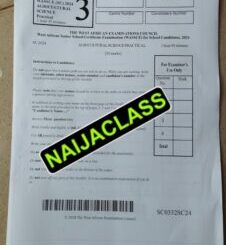Welcome to “Naijaclass Academy” For Waec 2024 Geography Practical and Physical Answers
Date: Friday, 31st May 2024
Geography (Practical and Physical) 3:30 pm. – 5:20 pm
——————————
(1b)
(i) River Nyamsu flows south-west to north-east.
(ii) The ridge at the south-eastern part of the mapped area is called Nyambene hill
(iii) Jimisokakraba settlement is located at the south-western part of the mapped area.
(1c)
(i) It is a ridge.
(ii) It runs from the south-western to north-eastern part of the mapped area.
(iii) It has a gentle slope on the north-western side and a steep slope on the south-eastern side.
(1d)
(i) The ridge in the south-eastern part of the area makes it difficult to construct roads and railways.
(ii) The gentle slope on the north-western side of the ridge makes it easier to construct roads and railways.
(iii) The Nyamsu river makes it necessary to construct bridges or use ferries to cross it.
(1b)
(i) River Nyamsu flows south-west to north-east.
(ii) The ridge at the south-eastern part of the mapped area is called Nyambene hill
(iii) Jimisokakraba settlement is located at the south-western part of the mapped area.
(1c)
(i) It is a ridge.
(ii) It runs from the south-western to north-eastern part of the mapped area.
(iii) It has a gentle slope on the north-western side and a steep slope on the south-eastern side.
(1d)
(i) The ridge in the south-eastern part of the area makes it difficult to construct roads and railways.
(ii) The gentle slope on the north-western side of the ridge makes it easier to construct roads and railways.
(iii) The Nyamsu river makes it necessary to construct bridges or use ferries to cross it.
(1c)
(i) Linear Ridge: It extends in a line from the southwest to the northeast.
(ii) Elevation Change: Indicates significant elevation changes.
(iii) Natural Barrier: Acts as a barrier influencing rivers and settlement locations.
(1d)
(i) Route Alignment: Roads follow valleys and avoid steep slopes.
(ii) Settlement Proximity: Settlements are in flatter areas for easier access.
(iii) Bridges and Passes: Roads cross rivers at narrow points and avoid high ridges, using lower elevation gaps.
=====================================================================
(4a)
An igneous rock is a type of rock that is formed from the cooling and solidification of magma or lava. It can be either intrusive (formed below the Earth’s surface) or extrusive (formed above the Earth’s surface).
(4b)
(i)They have a crystalline structure
(ii)They are rich in minerals
(iii)They can have a glassy appearance (in the case of extrusive rocks)
(4c)
(i)They are a source of valuable minerals such as copper, gold, and silver
(ii)They are used as building materials (e.g., granite, basalt)
(iii)They are used as a source of energy (e.g., geothermal power)
(iv)They are used in the manufacture of cement and concrete
(v)They are a source of rare earth elements (e.g., neodymium, dysprosium)
=====================================================================
(5a)
(i)Soluble rocks (e.g., limestone, dolomite) that can be dissolved by water
(ii)High rainfall and runoff
(iii)Presence of fractures and joints in the rock
(5b)
A sinkhole is a depression in the ground that forms when a layer of rock or soil is dissolved or collapses.
-Characteristics of sinkholes include:
(i)They can be sudden or gradual in formation
(ii)They can be small or large in size
(iii)They often have steep sides and a flat bottom
-Mode of formation:
(i)Dissolution of rock by groundwater
(ii)Collapse of a cave or underground void
(iii)Subsidence due to mining or other human activities
=====================================================================
6a)
(i) Af: Tropical Rainforest climate.
(ii) Am: Tropical Monsoon climate.
(iii) Aw: Tropical Savanna climate.
6b
1.High Temperature: Af climates are typically characterized by consistently high temperatures throughout the year, with little seasonal variation.
2.Abundant Rainfall: These regions receive abundant rainfall, often exceeding 60 inches (1500 mm) annually, distributed fairly evenly throughout the year. There is no distinct dry season.
3.Tropical Rainforests: Af climates are commonly associated with lush tropical rainforests characterized by dense vegetation and a variety of plant and animal species.
4.High Humidity: Due to the continuous evaporation from the abundant rainfall and dense vegetation, humidity levels remain high throughout the year.
5.Cyclic Weather Patterns: Although there is no distinct dry season, there may be variations in rainfall intensity throughout the year, often influenced by factors such as the intertropical convergence zone (ITCZ) movement.
6.Limited Seasonal Variation: Af climates typically lack significant seasonal changes, with temperatures remaining warm to hot year-round and only minor fluctuations in weather patterns.
=====================================================================
(7a)
(i)Meanders
(ii)Oxbow lakes
(iii)Floodplains
(7b)
A pothole is a circular or oval-shaped hole in the bed of a river, formed by the grinding action of sand and pebbles.
-Characteristics of potholes include:
(i)They can be deep and narrow
(ii)They often have a smooth, polished surface
(iii)They can be found in areas of fast-flowing water
-Mode of formation:
(i)Erosion by sand and pebbles
(ii)Whirlpools and eddies in the water
=====================================================================
(8a)
Atmospheric resources refer to the natural resources that are found in the Earth’s atmosphere, including air, water vapour, and gases such as oxygen and nitrogen.
(8b)
(i)They are essential for human and animal life
(ii)They influence the Earth’s climate and weather patterns
(iii)They are used in industrial processes and energy production
(8c)
(i)Burning of fossil fuels, leading to air pollution and climate change
(ii)Deforestation and land use changes, leading to loss of oxygen and increased greenhouse gases
(iii)Industrial processes, leading to release of pollutants and toxic gases.
OR
*PRACTICAL AND PHYSICAL GEOGRAPHY*
(8a)
Atmospheric resources refer to the various components of the Earth’s atmosphere that are utilized or harnessed by humans for various purposes. These resources include air for breathing, wind energy for power generation, and atmospheric gases such as oxygen and nitrogen for industrial, agricultural, and scientific applications.
OR
Atmospheric resources could be the collective term for natural elements and phenomena found in the Earth’s atmosphere that are valuable or useful to humans. This includes not only the gases that make up the atmosphere, but also phenomena such as weather patterns, atmospheric circulation, and the ozone layer.
(8b)
(PICK ANY THREE)
(i)Air Quality and Human Health: The atmosphere provides the air we breathe, which is essential for human survival.Monitoring and managing atmospheric resources help ensure that the air remains safe for breathing.
(ii)Renewable Energy: The atmosphere contains wind energy, which can be harnessed through wind turbines to generate electricity.Harnessing wind energy contributes to a cleaner and more sustainable energy future.
(iii)Weather Prediction and Disaster Management: Atmospheric resources are crucial for weather prediction and forecasting, which helps communities prepare for and respond to natural disasters such as hurricanes, tornadoes, and droughts
(iv)Ecosystem Support: The atmosphere provides essential resources for terrestrial and aquatic ecosystems. Atmospheric gases such as oxygen and nitrogen are vital for supporting plant and animal life.
(v)Climate Regulation: Atmospheric resources play a key role in regulating Earth’s climate. Gases such as carbon dioxide, methane, and water vapor influence the greenhouse effect, which helps to maintain a stable temperature range suitable for life on Earth.
(8c)
(PICK ANY THREE)
(i)Burning Fossil Fuels: Combustion of coal, oil, and natural gas releases carbon dioxide, sulfur dioxide, and other pollutants into the atmosphere, contributing to air pollution and climate change.
(ii)Deforestation: Cutting down trees reduces the number of plants that can absorb carbon dioxide from the atmosphere, leading to increased greenhouse gas levels.
(iii)Industrial Processes: Manufacturing activities release various pollutants, including particulate matter, nitrogen oxides, and volatile organic compounds, which degrade air quality and contribute to global warming.
(iv)Agricultural Practices: Intensive farming methods, such as livestock production and the use of chemical fertilizers and pesticides, release methane and nitrous oxide, potent greenhouse gases, into the atmosphere.
(v)Waste Management: Improper disposal of waste, including landfilling and open burning, releases methane and other pollutants into the air, contributing to both air pollution and climate change.
=====================================================================









I want to see answer
I want to see answer
Yoo do you got geography
Answer
Afa them don send you the answer
I want to see answer
I want to see answer
Yoo do you got geography
Answer
Afa them don send you the answer
Pls how do I get the questions and the answers
Pls how do I get the questions and the answers
If you are using small phone can you join
If you are using small phone can you join
How can I get it
How can I get it
Pls i demand geography essay answer
Pls i demand geography essay answer
Where are answers
I need geography practicals question
Where are answers
I need geography practicals question